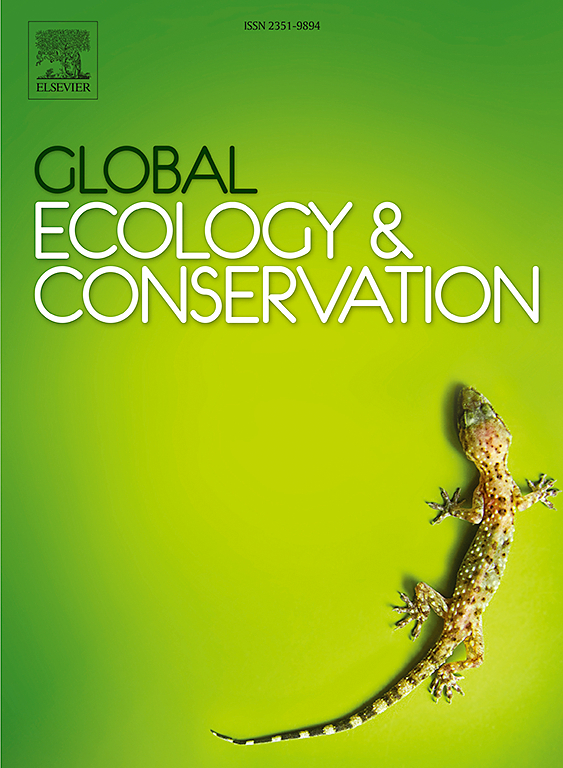自花授粉导致的种子遗传质量下降是限制濒危植物四棱草再生的关键因素
IF 3.5
2区 环境科学与生态学
Q1 BIODIVERSITY CONSERVATION
引用次数: 0
摘要
四电子,我是奥利夫。是始新世的一种濒临灭绝的孑遗物种,在自然界中主要依靠自花授粉。然而,自花授粉对种子质量、幼苗活力和种群更新的影响尚不清楚。本研究采用自花授粉、同族授粉、异种授粉和自然授粉4种授粉处理方法对柽桐花序进行授粉。随后,收集每个处理的种子并评估其表型特征和萌发特性。然后,我们对幼苗进行了为期5个月的连续监测,评估了它们的初始生长情况,并建立了动态生命表来跟踪它们的发育进程。结果表明,与其他授粉处理相比,自花授粉处理的水杨树种子表现出较差的表型性状,包括长度、宽度、厚度和千粒重的减少,发芽率和萌发指数也较低。此外,与异花授粉的幼苗相比,自花授粉的幼苗茎短,子叶小,干重减少,主根长。与异花授粉的幼苗相比,它们的存活率更低,死亡率更高。死亡密度和危害率函数分析显示,2月龄期青松幼苗的死亡高峰和失败风险最高,表明这一时期存在潜在的挑战。综上所述,自花授粉通过降低种子的遗传质量和幼苗的活力,对白桦的生存造成了严重的威胁。因此,通过人工异花授粉提高白桦种子的遗传质量可能是促进种群更新和支持未来保护工作的重要策略。本文章由计算机程序翻译,如有差异,请以英文原文为准。
The reduction in genetic quality of seeds resulting from self-pollination acts as a pivotal factor limiting the regeneration of the endangered plant Tetracentron sinense Oliv
Tetracentron sinense Oliv., an endangered relict species from the Eocene, primarily relies on self-pollination in nature. However, the impacts of self-pollination on seed quality, seedling viability, and population renewal remain unclear. In this study, we applied four pollination treatments (self-pollination, geitonogamy, xenogamy, and natural pollination) to the inflorescences of T. sinense. Subsequently, seeds from each treatment were collected and evaluated for their phenotypic characteristics and germination traits. We then conducted a five-month continuous monitoring of seedling survival, assessed their initial growth, and established a dynamic life table to track their development progress. Our findings revealed that self-pollinated T. sinense seeds exhibited inferior phenotypic traits, including decreased length, width, thickness, and 1000-grain weight, as well as lower germination rates and germination indices compared to seeds from the other pollination treatments. Furthermore, self-pollinated seedlings displayed shorter stems, smaller cotyledons, and reduced dry weights, but had longer taproots than cross-pollinated seedlings. They also showed lower survival rates and higher mortality rates than cross-pollinated seedlings. Analysis of the mortality density and hazard rate functions revealed a significant mortality peak and the highest failure risk at the two-month stage in T. sinense seedlings, indicating potential challenges during this period. In conclusion, our results indicate that self-pollination poses a significant threat to the survival of T. sinense by reducing seed genetic quality and seedling viability. Consequently, enhancing the genetic quality of T. sinense seeds through artificial cross-pollination could be a crucial strategy for promoting population renewal and supporting conservation efforts in the future.
求助全文
通过发布文献求助,成功后即可免费获取论文全文。
去求助
来源期刊

Global Ecology and Conservation
Agricultural and Biological Sciences-Ecology, Evolution, Behavior and Systematics
CiteScore
8.10
自引率
5.00%
发文量
346
审稿时长
83 days
期刊介绍:
Global Ecology and Conservation is a peer-reviewed, open-access journal covering all sub-disciplines of ecological and conservation science: from theory to practice, from molecules to ecosystems, from regional to global. The fields covered include: organismal, population, community, and ecosystem ecology; physiological, evolutionary, and behavioral ecology; and conservation science.
 求助内容:
求助内容: 应助结果提醒方式:
应助结果提醒方式:


